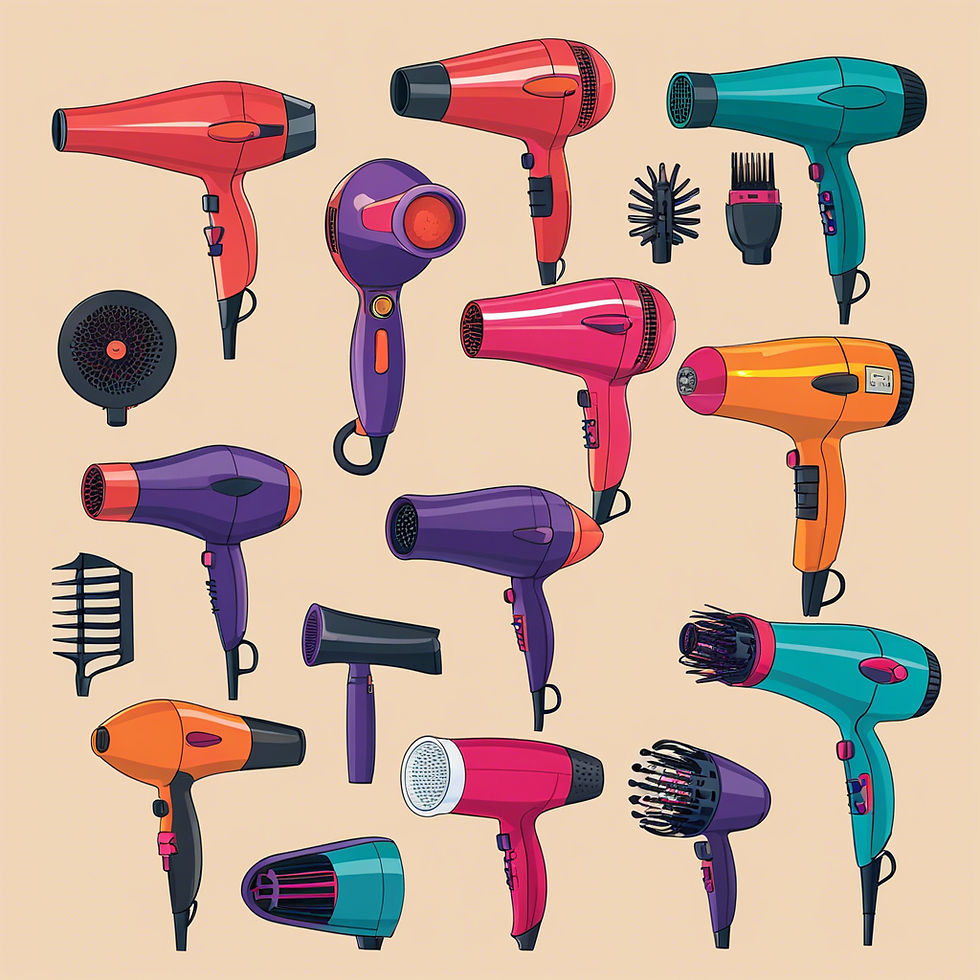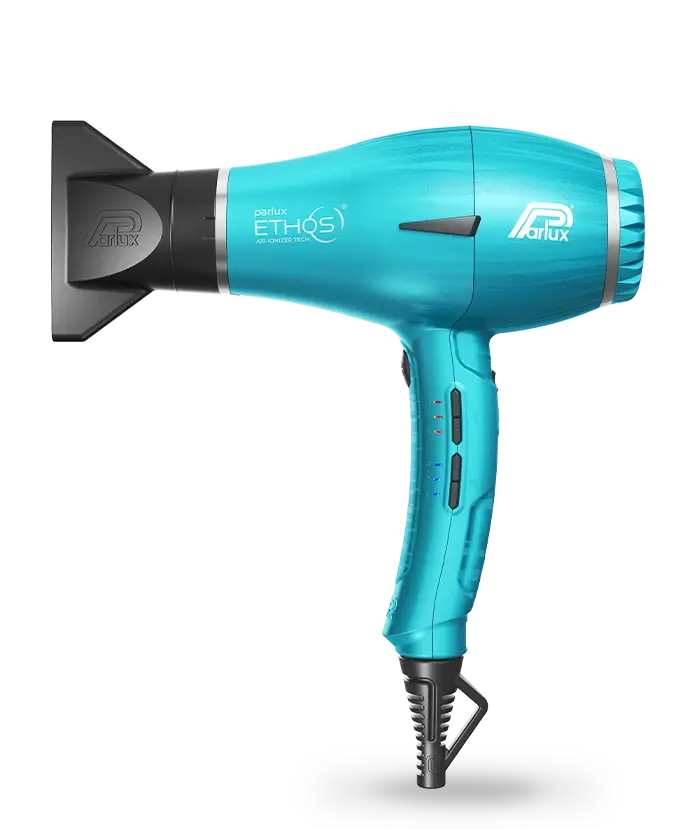
26 Oct 2024
For hairdressers, a high-quality hairdryer is one of the most critical tools of the trade. With a range of designs and technologies available, knowing which dryer best suits a particular hair type, styling goal, or salon environment can significantly impact both efficiency and client satisfaction. Here, we break down the main types of professional hairdryers, highlighting their benefits, limitations, and ideal use cases.
1. Ceramic Hairdryers

Features and Technology
Ceramic hairdryers use ceramic or porcelain heating elements, which provide consistent and even heat distribution. Unlike metal coils, which can cause heat spikes, ceramic components ensure that the heat is more uniform and gentle, making it ideal for various hair types.
Best Uses
• All Hair Types: Ceramic hairdryers are safe and effective for most hair textures, from fine to thick.
• Smooth and Shiny Finish: The even heat distribution helps minimize frizz, resulting in a smoother, shinier finish.
• Sensitive or Damaged Hair: The gentle, steady heat is less likely to cause overheating, making it suitable for clients with color-treated or otherwise damaged hair.
Pros
• Reduces frizz and promotes shine
• Gentle and consistent heat
• Suitable for everyday use
Cons
• May not be powerful enough for coarser hair textures if they require fast styling
2. Tourmaline Hairdryers
Features and Technology
Tourmaline is a crystalline mineral that emits negative ions when heated. These negative ions break down water molecules in the hair, allowing it to dry faster while locking in moisture.
Best Uses
• Frizzy or Curly Hair: Tourmaline’s ionizing effect is ideal for reducing frizz and smoothing out curls.
• Speed Drying: The faster drying capability makes it suitable for clients with dense or thick hair who want a speedy blowout.
• Dryer Hair Types: The moisture-locking benefits help keep hair hydrated, making it perfect for drier or color-treated hair.
Pros
• Reduces drying time significantly
• Reduces frizz and enhances shine
• Locks in moisture for softer hair
Cons
• Generally more expensive
• Not as effective for fine, flat hair
3. Ionic Hairdryers

Features and Technology
Ionic hairdryers emit negative ions, which, like tourmaline dryers, help break down water molecules and reduce static and frizz. Ionic dryers are popular for their quick drying time and their ability to smooth hair.
Best Uses
• Thick and Textured Hair: The fast drying time and frizz control make it an excellent choice for thicker, coarser hair types.
• Sleek and Polished Finish: Great for creating a smooth, polished finish without flyaways.
• Wavy to Curly Hair: Helps reduce curl shrinkage, keeping waves and curls defined without excessive frizz.
Pros
• Fast drying with less heat exposure
• Adds shine and reduces frizz
• Ideal for clients with thick or curly hair
Cons
• Can weigh down fine hair, reducing volume
• Typically more costly than basic dryers
4. Titanium Hairdryers

Features and Technology
Titanium hairdryers are known for their lightweight build and high heat output. Titanium also provides consistent, even heating, similar to ceramic but often with a lighter, more durable design.
Best Uses
• Thick, Coarse, and Long Hair: The high, steady heat output allows for faster drying, making it ideal for thicker or longer hair types.
• Busy Salons: The lightweight design reduces fatigue during long sessions, which can be beneficial for stylists working with many clients in a day.
Pros
• Lightweight and easy to handle
• Provides steady, high heat for fast drying
• Durable, long-lasting construction
Cons
• High heat may be too intense for fine or damaged hair
• Not the best option for clients with sensitive or fragile hair
5. Infrared Hairdryers

Features and Technology
Infrared hairdryers use infrared light to gently heat hair from the inside out, providing a less aggressive drying experience. This type of dryer is becoming popular for its gentle and effective approach to drying.
Best Uses
• Sensitive or Damaged Hair: Infrared heat is gentler on the hair, making it a go-to option for clients with compromised hair health.
• Soft, Natural Styles: Provides a more natural finish, ideal for clients looking for soft, subtle waves rather than sleek, polished styles.
• Low Heat Styling: Useful when lower heat settings are needed to avoid damage.
Pros
• Gentle on hair and scalp
• Helps reduce heat-related damage
• Smooths and softens without frizz
Cons
• Not as quick as other types for thick, coarse hair
• Higher price point
6. Cordless Hairdryers
Features and Technology
Cordless hairdryers are the latest addition to the professional styling world, offering freedom of movement and flexibility. Many models use rechargeable lithium-ion batteries, which are typically powerful enough for a full drying session.
Best Uses
• Mobile Stylists: Ideal for on-the-go stylists who need flexibility and portability.
• Quick Touch-ups: Convenient for backstage or on-set environments where quick touch-ups are needed.
Pros
• Freedom from cords
• Portable and convenient
• Generally lightweight
Cons
• Battery life may not be long enough for full services
• Less power than traditional professional dryers
Choosing the Right Hairdryer for Your Clients
In a salon environment, having a variety of dryers can be beneficial, especially when catering to diverse hair types and styles. Here are some tips for choosing the right hairdryer for different scenarios:
1. Assess Hair Type and Condition: Choose ionic or tourmaline dryers for clients with thick or frizzy hair, while opting for ceramic or infrared for finer or damaged hair.
2. Styling Needs: For sleek, straight styles, ionic or tourmaline dryers are excellent. For natural, soft looks, consider ceramic or infrared options. If volume and body are desired, a non-ionic or ceramic model may be preferable to avoid weighing the hair down.
3. Consider Ergonomics: If your work involves long sessions, a lightweight titanium or cordless model may be less fatiguing and increase efficiency.
4. Versatility for a Busy Salon: Many salons benefit from keeping a combination of ceramic, tourmaline, and ionic dryers available to meet the varied demands of their clientele.
Final Thoughts
Understanding the features and benefits of each type of professional hairdryer allows you to tailor your services to client needs more effectively. Whether creating a sleek blowout or a textured, voluminous look, the right dryer can elevate results, minimize damage, and leave clients with a look they love. Keep these types and tips in mind to maximize both styling potential and client satisfaction in your salon.
